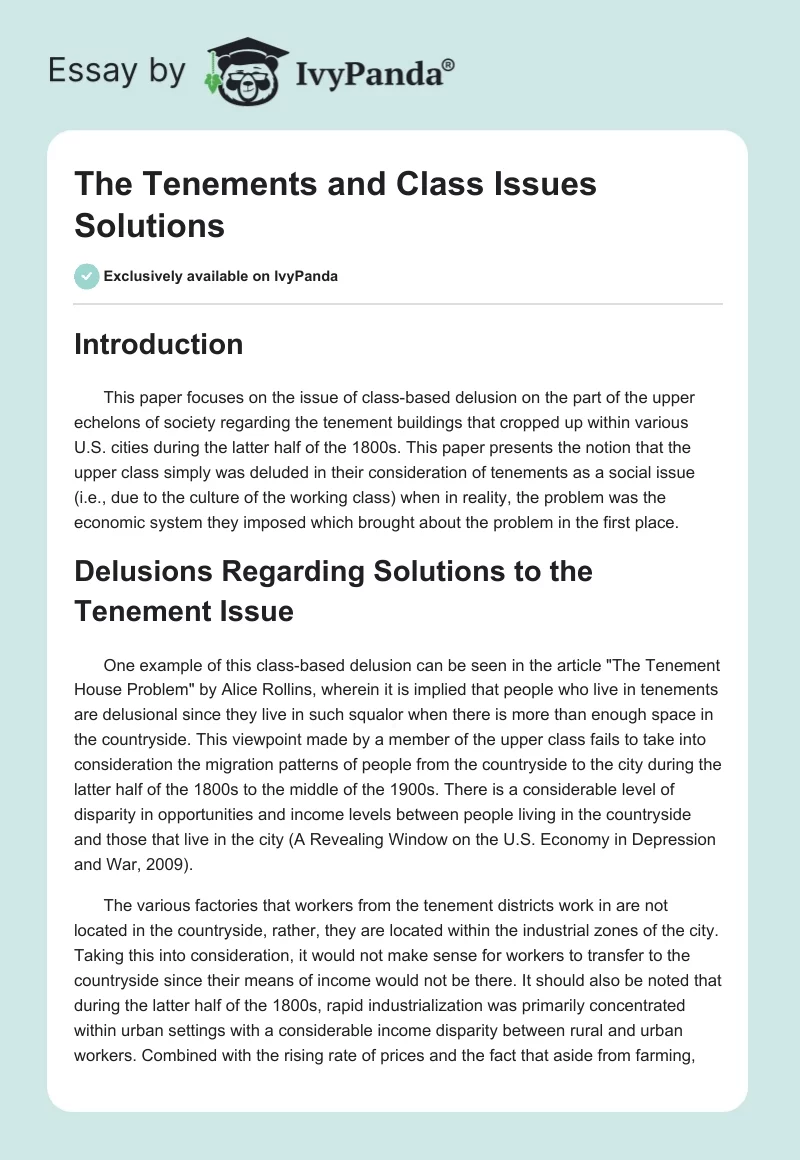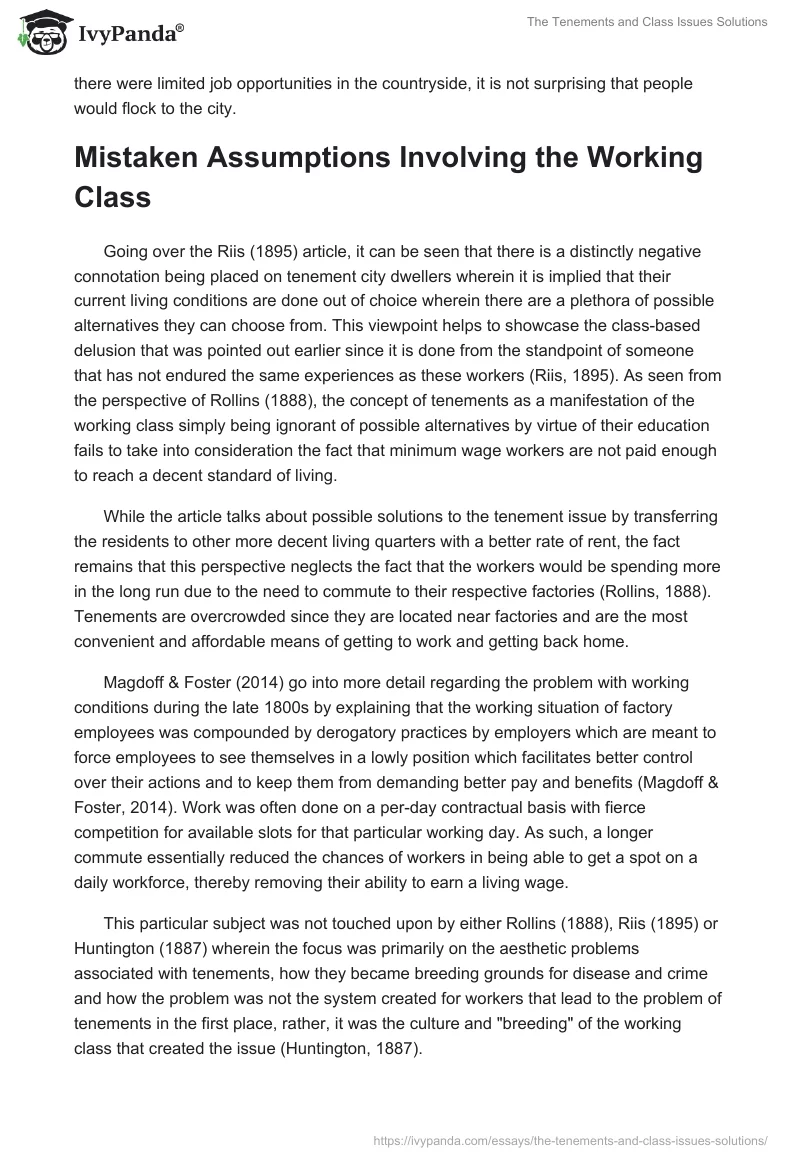Introduction
This paper focuses on the issue of class-based delusion on the part of the upper echelons of society regarding the tenement buildings that cropped up within various U.S. cities during the latter half of the 1800s. This paper presents the notion that the upper class simply was deluded in their consideration of tenements as a social issue (i.e., due to the culture of the working class) when in reality, the problem was the economic system they imposed which brought about the problem in the first place.
Delusions Regarding Solutions to the Tenement Issue
One example of this class-based delusion can be seen in the article “The Tenement House Problem” by Alice Rollins, wherein it is implied that people who live in tenements are delusional since they live in such squalor when there is more than enough space in the countryside. This viewpoint made by a member of the upper class fails to take into consideration the migration patterns of people from the countryside to the city during the latter half of the 1800s to the middle of the 1900s. There is a considerable level of disparity in opportunities and income levels between people living in the countryside and those that live in the city (A Revealing Window on the U.S. Economy in Depression and War, 2009).
The various factories that workers from the tenement districts work in are not located in the countryside, rather, they are located within the industrial zones of the city. Taking this into consideration, it would not make sense for workers to transfer to the countryside since their means of income would not be there. It should also be noted that during the latter half of the 1800s, rapid industrialization was primarily concentrated within urban settings with a considerable income disparity between rural and urban workers. Combined with the rising rate of prices and the fact that aside from farming, there were limited job opportunities in the countryside, it is not surprising that people would flock to the city.
Mistaken Assumptions Involving the Working Class
Going over the Riis (1895) article, it can be seen that there is a distinctly negative connotation being placed on tenement city dwellers wherein it is implied that their current living conditions are done out of choice wherein there are a plethora of possible alternatives they can choose from. This viewpoint helps to showcase the class-based delusion that was pointed out earlier since it is done from the standpoint of someone that has not endured the same experiences as these workers (Riis, 1895). As seen from the perspective of Rollins (1888), the concept of tenements as a manifestation of the working class simply being ignorant of possible alternatives by virtue of their education fails to take into consideration the fact that minimum wage workers are not paid enough to reach a decent standard of living.
While the article talks about possible solutions to the tenement issue by transferring the residents to other more decent living quarters with a better rate of rent, the fact remains that this perspective neglects the fact that the workers would be spending more in the long run due to the need to commute to their respective factories (Rollins, 1888). Tenements are overcrowded since they are located near factories and are the most convenient and affordable means of getting to work and getting back home.
Magdoff & Foster (2014) go into more detail regarding the problem with working conditions during the late 1800s by explaining that the working situation of factory employees was compounded by derogatory practices by employers which are meant to force employees to see themselves in a lowly position which facilitates better control over their actions and to keep them from demanding better pay and benefits (Magdoff & Foster, 2014). Work was often done on a per-day contractual basis with fierce competition for available slots for that particular working day. As such, a longer commute essentially reduced the chances of workers in being able to get a spot on a daily workforce, thereby removing their ability to earn a living wage.
This particular subject was not touched upon by either Rollins (1888), Riis (1895) or Huntington (1887) wherein the focus was primarily on the aesthetic problems associated with tenements, how they became breeding grounds for disease and crime and how the problem was not the system created for workers that lead to the problem of tenements in the first place, rather, it was the culture and “breeding” of the working class that created the issue (Huntington, 1887).
Origin of Tenements
In order to better understand the problem at hand, the work of Shiells (1990) was examined, which delved into the history of tenements within the U.S. during the late 1800s to mid-1900s and how such locations came to be. Shiells (1990) explained that workers received low wages not out of choice but due to the current labor and social system in place, which kept wages down in order to keep workers in their positions (Shiells, 1990).
The economic system that was in place during the late 1800s did not benefit low wage workers at all, and low-income housing had all but disappeared within the cities. When comparing the account of Shiells (1990) with either Rollins (1888), Riis (1895) or Huntington (1887), it is immediately noticeable that solutions to the issue ranged from charity, philanthropy, encouraging tenement dwellers to live in the countryside or to educate them regarding the health concerns with living in cramped spaces, yet in no account was there a suggestion that the issue was the very system that the upper class had created themselves.
This suggests that society required unskilled laborers to remain in the positions they were in so that the upper echelons of society could benefit. Through the work of Shiells (1990), it was noted that the wages being given in the various factories were notoriously low, with the general environment promoting a variety of health problems due to pollution. No attempt was made to improve conditions, whether it came in the form of higher wages or better working conditions due to the higher costs associated with such actions. The fact was that if laborers received higher wages, this would result in higher costs of operations for the upper class, which would noticeably deplete their profits. By keeping wages low, the price of services and various products continued to be competitive, resulting in better profits.
The System of Employment
Delving more into the topic, Persily (2013) notes that the problem with the system of employment that existed in the late 1880s for labor was that it was virtually designed to limit the rights of employees and give more power to the employer. The limited slots of workers per day ensured the workers would be more concerned with getting a job rather than demand better wages (Persily, 2013). This is done to ensure the compliance of laborers towards work practices and ensure that they would have no option but to go to work again the next day.
Taking all these factors into consideration, it becomes immediately obvious that the creation of tenements was in part due to the system that was instituted by the upper class to maximize their profits at the expense of ordinary workers. The fact that those belonging to the upper class were even complaining about the existence of tenement buildings when they are the main reason behind their creation speaks volumes about a class-based delusion involving the treatment of the working class.
Conclusion
Upon closer examination, it can be seen that the entire system of employment that was instituted during the late 1880s was inherently constructed so as to imprison people within a certain role and within a certain economic class to benefit those above. The system, in effect, fostered class and economic inequality for the benefit of the select few, leaving little if next to no choice for those at the very bottom rung of the ladder of society. From this perspective, it can be stated that the upper echelons of society within the U.S. at the time were simply deluded regarding their view of the urban working class. They viewed the issue of tenements as a cultural issue brought about by a lack of education and improper breeding when in reality it was all the result of greed on the part of corporate interests that fostered low wages and a terrible working system that forced the creation of tenements in the first place.
Reference List
A Revealing Window on the U.S. Economy in Depression and War. (2009). Independent Review, 14(1), 151-160. Web.
Huntington, J. (1887). Tenement-house morality. American Periodicals, 3(5), 513. Web.
Magdoff, F., & Foster, J. (2014). The Plight of the U.S. Working Class. Monthly Review: An Independent Socialist Magazine, 65(8), 1-22. Web.
Persily, A. K. (2013). Where It All Started. ASHRAE Journal, 55(7), 126-128. Web.
Riis, J. (1895). The tenement the real problem of civilization. American Periodicals, 1(2), 83. Web.
Rollins, A. (1888). The tenement-house problem. American Periodicals, 1(1), 207. Web.
Shiells, M. (1990). Collective Choice of Working Conditions: Hours in British and U.S. Iron and Steel, 1890-1923. Journal Of Economic History, 50(2), 379. Web.


